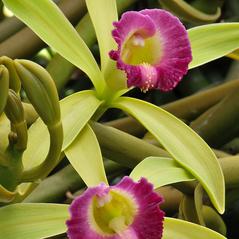Vanilla dilloniana Correll
Dillon's Vanilla
Facts About
There are no synonyms for this orchid
Vanilla dilloniana, commonly known as Dillon's Vanilla, is distributed throughout the West Indies and had been reported on the banks of the Miami River in south Florida. Shoots form a multi-branched, leafless vine that can reach lengths up to 5 m. The light green flowers are similar to Vanilla barbellata but the petals and sepals are longer and the fluted lip is a deep reddish-purple with a yellow crest. This orchid grows in areas with a limestone substrate, such as coastal berms and hardwood hammocks.
Vanilla dilloniana is considered vulnerable across its range and endangered in Florida. Although this species may be extirpated in Florida, pieces of plants from the original colony have been shared and may be found in local collections.
Pollination
Pollinator information for this orchid has not been reported but Vanilla species are often pollinated by large euglossine bees.
Ecosystem Type
Woodlands
Characteristics
- Habitat:
- epiphyte
- Leaf arrangement:
- alternate
- Form of the labellum:
- the labellum is not pouch-like
- Labellum outline:
- the labellum is lobed
- Main color of labellum:
-
- pink to red
- white
- Nectar spur:
- absent
- Inflorescence type:
- the inflorescence is a raceme
- Labellum characteristics:
- the labellum is lobed
- Labellum length:
- Up to 43 mm
- Sepal length:
- 48–55 mm
- Plant height:
- Up to 500 cm
-
Flowers
- Floral bract length:
- Up to 10 mm
- Flower petal color:
-
- green
- yellow
- Flower symmetry:
- the flower is zygomorphic
- Flowering date:
-
- June
- July
- Flowers per inflorescence:
- 1–8
- Form of the labellum:
- the labellum is not pouch-like
- Hairs on flower stalk:
- the pedicel is hairless
- Hairs on inflorescence axis:
- the inflorescence stem is hairless
- Inflorescence type:
- the inflorescence is a raceme
- Labellum characteristics:
- the labellum is lobed
- Labellum length:
- Up to 43 mm
- Labellum outline:
- the labellum is lobed
- Labellum position:
- the flowers are resupinate
- Lower petal strongly red-veined:
- yes
- Main color of labellum:
-
- pink to red
- white
- Nectar spur:
- absent
- Number of stamens:
- 1
- Orientation of side petals:
- the lateral petals are spreading
- Self-pollinating flowers:
- there are no cleistogamous flowers
- Sepal length:
- 48–55 mm
- Sepals fused only to sepals:
- the sepals are separate from one another
- Spots on labellum:
- no
-
Fruits or seeds
- Fruit length:
- Up to 160 mm
- Fruit width:
- Up to 12 mm
- Seed capsule orientation:
- the capsule bends downwards
-
Growth form
- Epiphyte form:
- vine
- Plant height:
- Up to 500 cm
- Roots:
- the rhizomes are non-coralloid
- Vine leaves:
- vine is essentially leafless except for the newest growth
- Vine node spacing:
- Leaves are shorter than the distance between nodes
- myco-heterotrophic or not:
- the plant is chlorophyllous
-
Leaves
- Bract relative length:
- the bract is shorter than the associated flower
- Leaf arrangement:
- alternate
- Leaf blade edges:
- the leaf edges are entire
- Leaf blade length:
- Up to 100 mm
- Leaf blade shape:
- lanceolate
- Leaf blade width:
- Up to 150 mm
- Leaves during flowering:
- leaves are absent during flowering
-
Place
- Ecosystem type:
- woodlands
- Habitat:
- epiphyte
- Location:
- Florida
-
Facts and Uses
- Mycorrhiza
- Monitoring
- Propagation
- Restoration
Native to North America
Yes
North American Conservation Status & Distribution
Conservation Status
| Conservation and Wetland Status | |
|---|---|
| Global Rank | Vulnerable |
| US Status | N/A |
| Canadian Status | N/A |
| Conservation status for: Florida | |
|---|---|
| Global Rank | Vulnerable |
| US Status | N/A |
| Florida Rank | N/A |
| Florida Status | Endangered |
| Canadian Status | N/A |
| Wetland Status | N/A |





